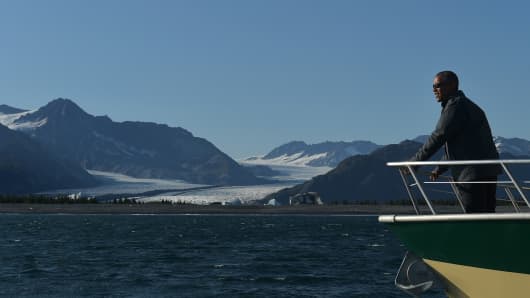This type of drilling is fraught with environmental risks. Here the dangers far out weigh the potential benefits (other than oil and gas companies continuing to get rich). Powering a new, green economy means preserving and protecting eco-capitol. Stopping drilling in the Artic and Atlantic does that and more:
CNBC
Tom DiChristopher | @tdichristopher
CNBC.com
President Barack Obama on Tuesday moved to indefinitely block drilling in vast swaths of U.S. waters.
The president had been expected to take the action by invoking a provision in a 1953 law that governs offshore leases, as CNBC previously reported.
The law allows a president to withdraw any currently unleased lands in the Outer Continental Shelf from future lease sales. There is no provision in the law that allows the executive's successor to repeal the decision, so President-elect Donald Trump would not be able to easily brush aside the action.
Trump has vowed to open more federal land to oil and natural gas production in a bid to boost U.S. output. Obama on Tuesday said he would designate "the bulk of our Arctic water and certain areas in the Atlantic Ocean as indefinitely off limits to future oil and gas leasing, though the prospects for drilling in the affected areas in the near future were already questionable.
U.S. Outer Continental Shelf
The lands covered include the bulk of the Beaufort and Chukchi seas in the Arctic and 31 underwater canyons in the Atlantic. The United States and Canada also announced they will identify sustainable shipping lanes through their connected Arctic waters.
Canada on Tuesday also imposed a five-year ban on all oil and gas drilling licensing in the Canadian Arctic. The moratorium will be reviewed every five years.
"These actions, and Canada's parallel actions, protect a sensitive and unique ecosystem that is unlike any other region on earth," Obama said in a statement.
"They reflect the scientific assessment that, even with the high safety standards that both our countries have put in place, the risks of an oil spill in this region are significant and our ability to clean up from a spill in the region's harsh conditions is limited."
The action potentially tees up a battle that touches on hot-button issues: environmental protection, energy independence, climate change, and the scope of executive power.

Mandel Ngan | AFP | Getty Images
President Barack Obama looks at Bear Glacier during a boat tour of the Kenai Fjords National Park on September 1, 2015 in Seward, Alaska. Bear Glacier is the largest glacier in Kenai Fjords National Par
Like other efforts by the Obama administration to advance environmental protection through executive action, it could also be challenged in the courts. It could get tied up there throughout much of Trump's four-year term.
The Republican-controlled Congress could also try to change the law.
The provision, contained in the 1953 Outer Continental Shelf Lands Act, has been invoked in the past to set aside smaller portions of the Outer Continental Shelf, such as coral reefs or natural habitats. Presidents George H.W. Bush and Bill Clinton used the provision to block drilling in much of the Outer Continental Shelf, but for limited periods.
The Obama administration's action marks the broadest use of the statute ever because it would be far-reaching in terms of the lands it would protect and come without an expiration date.
Provision 12(a) of the law states, "The President of the United States may, from time to time, withdraw from disposition any of the unleased lands of the outer Continental Shelf."
Momentum to use the provision has been building this year. In May, a coalition of environmental groups circulated a fact sheet that highlighted the authority provided under 12(a

No comments:
Post a Comment